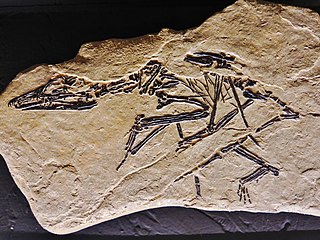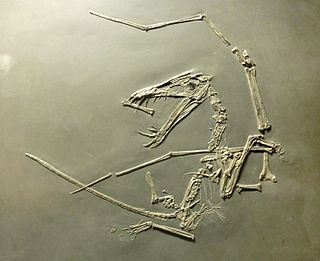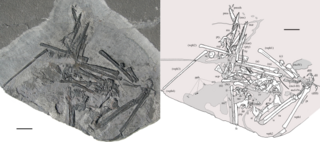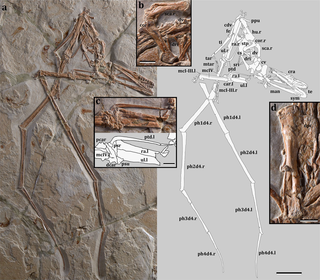
Pterosaurs are an extinct clade of flying reptiles in the order Pterosauria. They existed during most of the Mesozoic: from the Late Triassic to the end of the Cretaceous. Pterosaurs are the earliest vertebrates known to have evolved powered flight. Their wings were formed by a membrane of skin, muscle, and other tissues stretching from the ankles to a dramatically lengthened fourth finger.

Eudimorphodon was a pterosaur that was discovered in 1973 by Mario Pandolfi in the town of Cene, Italy and described the same year by Rocco Zambelli. The nearly complete skeleton was retrieved from shale deposited during the Late Triassic, making Eudimorphodon one of the oldest pterosaurs known. It had a wingspan of about 100 centimeters (3.3 ft) and at the end of its long bony tail may have been a diamond-shaped flap like in the later Rhamphorhynchus. If so, the flap may have helped it steer while maneuvering in the air. Eudimorphodon is known from several skeletons, including juvenile specimens.

Preondactylus is a genus of long-tailed pterosaurs from the Late Triassic that inhabited what is now Italy. It contains a single known species, Preondactylus buffarinii, which was discovered by Nando Buffarini in 1982 at the Forni Dolostone near Udine in the Preone valley of the Italian Alps.

Dorygnathus was a genus of rhamphorhynchid pterosaur that lived in Europe during the Early Jurassic period, when shallow seas flooded much of the continent. It had a short wingspan, and a relatively small triangular sternum, which is where its flight muscles attached. Its skull was long and its eye sockets were the largest opening therein. Large curved fangs that "intermeshed" when the jaws closed featured prominently at the front of the snout while smaller, straighter teeth lined the back. Having two or more morphs of teeth, a condition called heterodonty, is rare in modern reptiles but more common in basal ("primitive") pterosaurs. The heterodont dentition in Dorygnathus is consistent with a piscivorous (fish-eating) diet. The fifth digit on the hindlimbs of Dorygnathus was unusually long and oriented to the side. Its function is not certain, but the toe may have supported a membrane like those supported by its wing-fingers and pteroids. Dorygnathus was according to David Unwin related to the Late Jurassic pterosaur Rhamphorhynchus and was a contemporary of Campylognathoides in Holzmaden and Ohmden.

Peteinosaurus was a prehistoric genus of pterosaur. It lived in the late Triassic period in the late Norian age, and at a wingspan of around 60 cm (24 in), was one of the smallest and earliest pterosaurs, although other estimates suggest a wingspan of up to 1 m (3.3 ft).

Campylognathoides is an extinct genus of pterosaur discovered in the Württemberg Lias deposits of Germany; this first specimen however, consisted only of wing fragments. Further better preserved specimens were found in the Holzmaden shale; based on these specimens, Felix Plieninger erected a new genus.

Austriadactylus is a genus of primitive pterosaur. The fossil remains were unearthed in Late Triassic rocks of Austria.
Caviramus is a genus of caviramid pterosaur from the Late Triassic lower Kössen Formation of the Northern Calcareous Alps of Switzerland.
The Forni Dolostone, also known as the Dolomia di Forni, is a Late Triassic dolomite geological formation in northeastern Italy. The formation was deposited in a lagoonal to shallow marine environment.

Carniadactylus is a genus of pterosaur which existed in Europe during the Late Triassic period. The genus contains a single species, Carniadactylus rosenfeldi.
Faxinalipterus is a genus of ornithodiran archosaur, originally described as a pterosaur, from the Late Triassic Caturrita Formation of southern Brazil. A study from 2022 reinterpreted the fossil remains and instead suggests them to belong to a member of the Lagerpetidae, another clade of pterosauromorphs.

Eopterosauria is a proposed clade of basal pterosaurs from the Triassic. The term was first used in Andres et al. (2014) to include Preondactylus, Austriadactylus, Peteinosaurus and Eudimorphodontidae. Inside the group were two other new clades, Preondactylia, which included Preondactylus and Austriadactylus, and Eudimorphodontoidea, to include Eudimorphodontidae and Raeticodactylidae. Eopterosauria was defined as "the least inclusive clade containing Preondactylus buffarinii and Eudimorphodon ranzii". The specimen BSP 1994, previously assigned to Eudimorphodon, was named the separate taxon Austriadraco in 2015, and assigned to the new family Austriadraconidae, but further classification was not described. The following phylogenetic analysis follows the topology of Andres et al. (2014).

Eudimorphodontidae is an extinct family of early pterosaurs from the Late Triassic of Europe. It was named by Peter Wellnhofer in 1978 to include Eudimorphodon ranzii. Some phylogenetic analyses suggested that Eudimorphodontidae is a junior synonym of Campylognathoididae, however more comprehensive analyses found Eudimorphodontidae to be basal to Macronychoptera that includes Campylognathoididae and more derived pterosaurs (Breviquartossa). Wang et al. (2009) found Eudimorphodontidae to include six species, but they didn't defined the clade. Brian Andres define Eudimorphodontidae and found Peteinosaurus to be most closely related to it. Furthermore, he found monophyletic Eudimorphodon clade, and defined two subfamilies within Eudimorphodontidae. The Eudimorphodontinae includes all taxa more closely related to Eudimorphodon ranzii than to Raeticodactylus filisurensis while the Raeticodactylinae includes all taxa more closely related to Raeticodactylus filisurensis than to Eudimorphodon ranzii. More recently, Raeticodactylus and Caviramus were moved into their own family, Raeticodactylidae. The below cladogram follows that analysis.
Austriadraco is a genus of pterosaur living during the Late Triassic in the area of present Austria. Its only species—Austriadraco dallavecchiai—was previously attributed to Eudimorphodon, and its closest relatives may have been Eudimorphodon or Arcticodactylus.

Bergamodactylus is a putative genus of basal pterosaur which lived during the Late Triassic in the area of present-day Bergamo province in Italy. Its only species is Bergamodactylus wildi. It was named in 2015 based on a pterosaur specimen which had previously been regarded as a juvenile Eudimorphodon or as identical to Carniadactylus. Some Triassic pterosaur specialists consider the distinguishing features of Bergamodactylus to be invalid or insufficient to distinguish it from Carniadactylus, and thus retain the specimen in that genus.

Forfexopterus is a genus of ctenochasmatid pterosaur from the Early Cretaceous Jiufotang Formation in China. It contains a single species, F. jeholensis, named from a mostly complete skeleton by Shunxing Jiang and colleagues in 2016. A second specimen, consisting of a wing, was described in 2020. While the first specimen is larger, it shows signs of being less mature than the second specimen, indicating that the developmental trajectories of Forfexopterus were variable. Like other ctenochasmatids, Forfexopterus had a long, low skull filled with many slender teeth; unlike other members of the group, however, it did not have a spatula-shaped snout tip or crests, and its teeth were more curved. A single characteristic distinguishes Forfexopterus from all other members of the wider group Archaeopterodactyloidea: of the four phalanx bones in its wing finger, the first was shorter than the second but longer than the third.

Douzhanopterus is an extinct genus of monofenestratan pterosaur from the Late Jurassic of Liaoning, China. It contains a single species, D. zhengi, named by Wang et al. in 2017. In many respects, it represents a transitional form between basal pterosaurs and the more specialized pterodactyloids; for instance, its tail is intermediate in length, still being about twice the length of the femur but relatively shorter compared to that of the more basal Wukongopteridae. Other intermediate traits include the relative lengths of the neck vertebrae and the retention of two, albeit reduced, phalanx bones in the fifth digit of the foot. Phylogenetically, Douzhanopterus is nested between the wukongopterids and a juvenile pterosaur specimen from Germany known as the "Painten pro-pterodactyloid", which is similar to Douzhanopterus in many respects but approaches pterodactyloids more closely elsewhere.

Caelestiventus is a pterosaur genus from the Late Triassic found in western North America. The type species, Caelestiventus hanseni, honors Robin Hansen, the Bureau of Land Management geologist (BLM), who facilitated access to the excavation site.

Seazzadactylus is a basal pterosaur genus that lived during the late Triassic in the area of present Italy.

Mimodactylus is a genus of istiodactyliform pterosaur that lived in what is now Lebanon during the Late Cretaceous, 95 million years ago. The only known specimen was discovered in a limestone quarry near the town of Hjoula, belonging to the Sannine Formation. The owner of the quarry allowed the specimen to be prepared and scientifically described by an international team of researchers, and when it was eventually sold, the buyer donated it to the MIM Museum in Beirut. In 2019, the researchers named the new genus and species Mimodactylus libanensis; the generic name refers to the MIM Museum, combined with the Greek word daktylos for "digit", and the specific name refers to Lebanon. The well-preserved holotype specimen is the first complete pterosaur from the Afro-Arabian continent, and the third pterosaur fossil known from Lebanon.




























